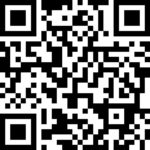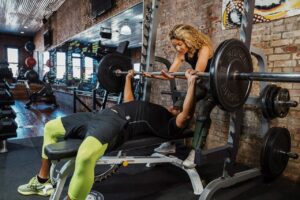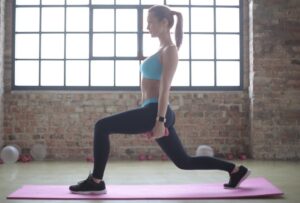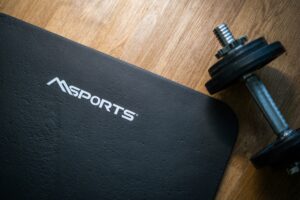The leg press is a popular exercise performed by trainees worldwide. Like squats, the leg press effectively overloads the lower body, leading to impressive strength and muscle gains.
But what if you’re sick of the movement or don’t have access to a leg press machine?
Luckily, there is a solution: do other, equally effective movements. This article will review 11 fantastic leg press alternative exercises for leg mass and strength.
What is the Leg Press, and What Makes It Effective?
The leg press is considered an isolation exercise because it primarily targets the quadriceps and involves one joint: the knee (1). But unlike other exercises in the category, leg presses offer benefits similar to those from compound lifts.
An advantage of the exercise is that it allows you to overload your lower body with more weight. Trainees are often capable of leg pressing more weight than they can squat, which promotes mechanical tension that supports hypertrophy (2).
To perform the leg press, you must sit inside a machine, place your feet on a platform, and engage your lower body muscles to repeatedly press the platform away from yourself. The movement is similar to a squat but easier to perform because you don’t have to worry about stability, optimal body alignment, and such.
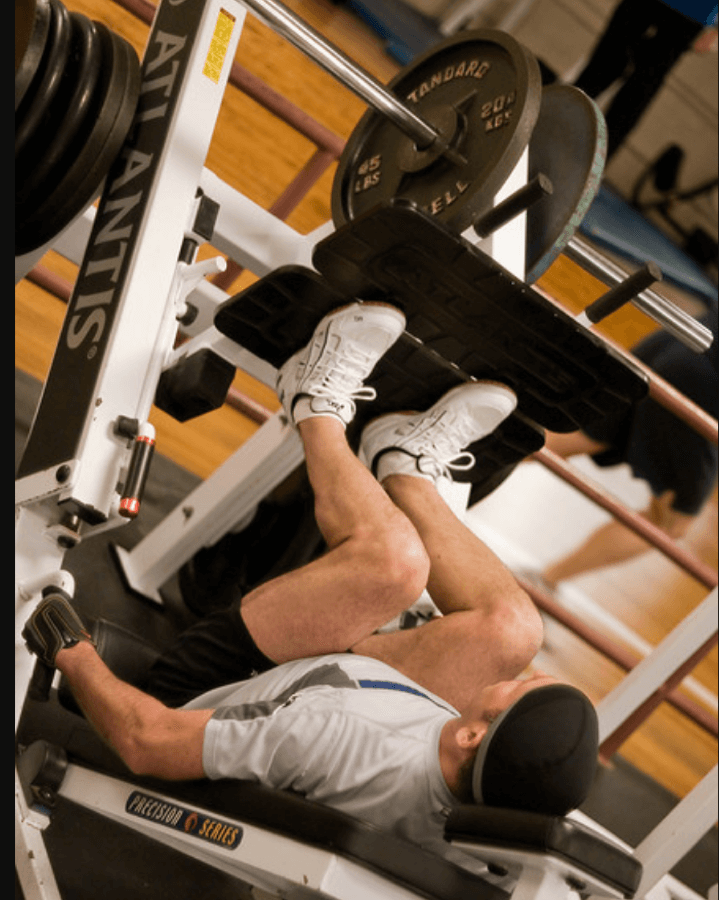
There are several types of leg press machines. The two primary types are the standard (angled) one, where you press the platform forward and up, and the horizontal one, where you maintain a more horizontal body position.
The leg press is a favourite exercise of many trainees for several reasons.
1. Easy to Learn
Most notably, it is easier to learn, especially when compared to squats. Plenty of trainees prefer to stick with the more straightforward leg press instead of making an effort to master the squat and similar compound exercises.
2. Back Support
Unlike compound exercises like the back squat, where the barbell rests behind your neck and on top of your trapezius muscle, leg presses offer excellent spinal support because your back is positioned against a padded platform. As a result, you experience much less back stress and are less likely to aggravate an old injury.
3. Safe to Do
Every leg press machine has safety catches that allow you to rack the weight at almost any point. If you attempt to lift more weight than you can handle or take a set to failure and struggle to complete the last rep, rack the weight and escape safely.
4. Great Overloading Potential
Another reason why trainees love the leg press is that it allows them to use a lot of weight and feel stronger. Of course, that can often result in ego lifting, but lifting greater loads with proper form can result in excellent quad growth and strength development.
5. Experiment with Intensity Techniques
The final reason trainees love the leg press is that it works excellently with intensity techniques, such as dropsets and giant sets.
For example, you can do a set with a heavy load, remove a couple of plates, do a few more reps, and repeat several times until you’ve stripped all the weight.
Such techniques are not mandatory for effective training, but they allow lifters to do more work in less time and switch things up.
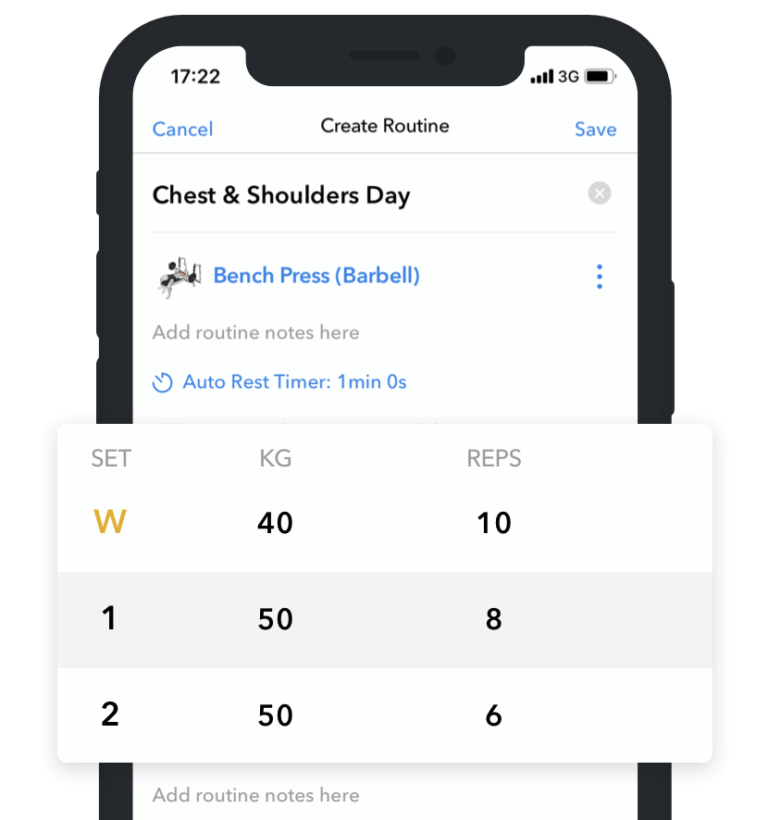






Hevy – Workout Tracker
Create and log your leg press alternative exercises with Hevy and track your progress
What Muscles Does the Leg Press Work?
As briefly mentioned, the leg press is considered an isolation exercise despite sharing many similarities with squats. It primarily trains the quadriceps, which make up the front portion of the thighs and produce knee extension (straightening of the legs) (1, 3).
In addition to the quadriceps, leg presses involve the glutes, hamstrings, calves, and adductors (inner thigh muscles) to some degree. Tweaking your foot stance and range of motion can affect muscle activation.
For instance, a wider stance with toes pointing out is more beneficial for the adductors. In contrast, a narrower stance puts greater emphasis on the quadriceps.
Placing your feet lower on the platform makes the exercise more knee-dominant and improves quadriceps activation. In contrast, having your feet higher on the platform and training through a more extended range of motion leads to greater glute involvement.
Your midsection (abs, obliques, lower back, etc.) also plays a minor role in the leg press but isn’t nearly as active as in squats and other free-weight activities.
Leg Press Alternative Exercises With Machines
1. Smith Machine Leg Press
A Smith machine leg press is one of the best leg press variations. You can perform these if you’re tired of the classic leg press or your gym doesn’t have a vertical leg press machine.
Unlike a regular leg press, where you sit inside a machine and press a platform away from yourself, the Smith machine leg press is slightly different.
You must lie on the floor, raise your feet toward the ceiling, and place them against the Smith machine bar. As a result, the direction of pressing is straight up.
It’s best to start with an empty bar and have someone spot you while you’re first learning to do the exercise because it can be challenging.
How to:
- Set the Smith machine bar at hip height.
- Place an exercise mat on the floor and lie down. Position your arms to your sides with your hands flat on the floor for balance.
- Raise your legs toward the ceiling and place the middle of your feet against the bar. Your feet should be roughly shoulder-width apart with your knees bent.
- Engage your abs and inhale.
- Grab the bar with both hands and carefully unrack it while supporting it with your feet.
- Inhale and slowly lower the bar while keeping your back in contact with the exercise mat.
- Pause at the bottom and press the bar, exhaling near the top.
- Once finished, rotate the bar to the initial position with your feet to rack it.
Pro tip:
Pay attention to the bar’s range of motion during the exercise and set the safety pins below that level. That way, the bar will never fall on you, even if you lose your footing or get too tired to complete the last repetition.
2. Hack Squat (Machine)
Hack squats are an excellent exercise, especially for those with no leg press machine. The movement is an effective leg press alternative because the two share many similarities:
- Identical range of motion
- Similar movement pattern
- Excellent overloading potential
- Good back support
- Emphasis on the knees and quadriceps
- Safe to perform, even for people with old injuries
- Easy to learn, which makes them perfect for beginners
The primary difference is the direction of pressing. Leg presses traditionally have you push the weight horizontally or upward, whereas a hack squat is more similar to a regular barbell squat. You place the weight on your shoulders and move up and down by bending and extending your knees.
How to:
- Add the appropriate load to the hack squat machine.
- Set yourself up by positioning your back against the padded platform and shoulders against the top pads. Next, grab the handles to the sides of your head.
- Position your feet in a comfortable stance with your toes pointing slightly out. Keep your knees slightly bent.
- Retract your shoulder blades, take a deep breath, and squeeze your abs.
- Press through your heels to straighten your legs and unrack the weight with the handles.
- Take another breath and descend by bending your knees.
- Go down until your knees are at a 90-degree angle, and pause for a moment.
- Press through your heels and flex your quads to straighten your legs. Exhale near the top.
- Once finished, rack the weight and take a break.
Pro tip:
Treat the movement as you would a regular squat. Find your optimal foot position and width to ensure a strong base, and always keep your heels on the floor.
One common mistake trainees make is lifting their heels off the platform and pressing through the balls of their feet, which creates a lot of joint stress and leads to instability.
3. Smith Machine Squat
Smith machine squats are among the more effective leg press variations. Like hack squats, the movement shares numerous similarities to the leg press, which makes it the ideal replacement.
The range of motion, movement pattern, and overloading potential are identical, both exercises train the same muscles, and neither is necessarily hard to master.
One difference between Smith machine squats and the leg press is that the former doesn’t have the same back support. Instead, you must rely on proper midsection bracing to keep your spine in a strong and stable position, similar to a regular squat.
How to:
- Set the Smith machine bar at chest height and add the appropriate weight.
- Place your hands evenly on the bar and tuck your head underneath, placing your upper back against it, similar to a barbell squat.
- Walk your feet forward to position them up to one foot in front of your torso.
- Position your feet roughly shoulder-width apart with your toes pointing slightly out.
- Retract your shoulder blades, take a deep breath, and flex your abs.
- Press through your heels to lift the Smith machine bar and rotate it slightly to unrack.
- Take another deep breath and descend until your thighs are parallel to the floor.
- Pause at the bottom for a moment and press through your heels to straighten your legs. Exhale near the top.
- Inhale again and repeat.
- Once finished, turn the bar in the opposite direction to rack it before relaxing your body.
Pro tip:
You can keep your feet directly under the Smith machine bar and do the exercise as you would a regular barbell squat. But due to the fixed bar path, the movement can feel awkward and result in significant spinal loading.
Walking your feet out keeps your back in a healthy position and allows you to emphasize the quadriceps, similar to a leg press.
4. Leg Extension (Machine)
Leg extensions on a machine are a practical leg press substitute. Moreover, the two share some similarities that make them interchangeable.
One notable benefit of leg extensions is that the overloading potential is decent. The quadriceps are large, four-headed muscles with excellent potential for force production, allowing you to progress more quickly, even weekly. Stronger trainees can often lift 155, 175, or even 200+ lbs.
In addition, the range of motion is identical, and the two exercises develop the quadriceps without putting any stress on the back.
How to:
- Select the appropriate weight on the machine.
- Set the back support for your knees to be just over the edge of the seat when you sit down.
- Set the bottom pad to be just over your feet when you set yourself up.
- Sit down, position your back against the pad, and place the bottom pad against your lower shins.
- Grab the handles to your sides for stability, retract your shoulder blades, and take a deep breath.
- Flex your quadriceps to extend your legs against the resistance, pausing at the top position for a moment.
- Slowly bend your knees but keep the weight off the stack to maintain tension on your quadriceps. Exhale.
- Inhale again and repeat.
- Once finished, lower the weight to its stack and take a break.
Pro tip:
Start with a lighter weight that allows you to do at least 12 smooth and controlled repetitions through a full range of motion. Doing so will help you establish a stronger mind-muscle connection and develop your quadriceps more effectively.







Hevy – Workout Tracker
Create and log your leg press alternative exercises with Hevy and track your progress
Leg Press Alternative Exercises with Free Weights (Dumbbells, Barbell, etc.)
5. Goblet Squat
Goblet squats are an effective leg press dumbbell alternative. To perform these, you must hold a weight in front of your chest, which forces you to maintain a more upright torso. As a result, hip extension occurs to a much smaller degree, and your quadriceps have to do most of the work (4).
A notable benefit of the exercise is that it develops your upper back and midsection alongside the quads. You can work up to a respectable weight and cause the necessary overload for muscle and strength gain.
How to:
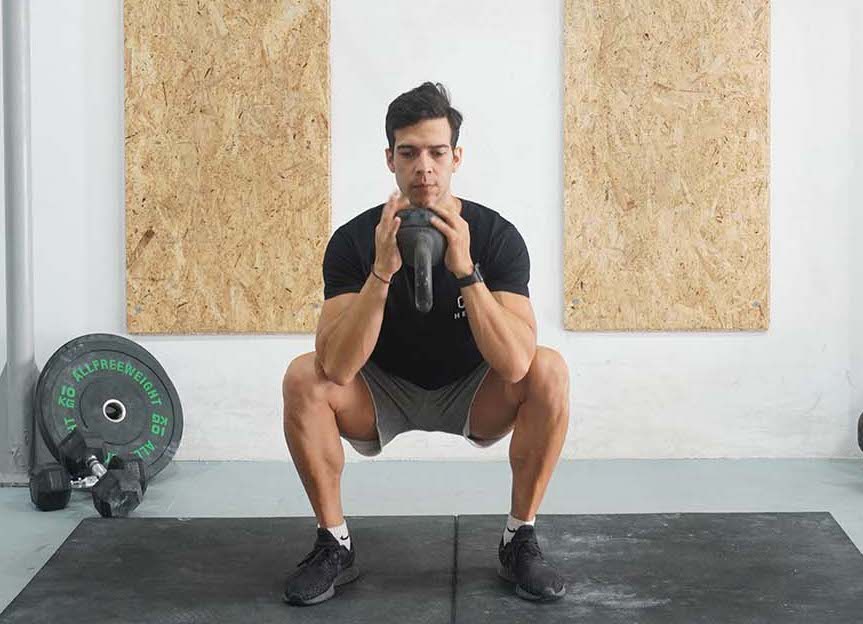

- Grab a dumbbell and lift it in front of your chest. Have the dumbbell in a vertical position and place your palms against the top weight plate with your fingers on top for extra support.
- Have your feet in a comfortable stance with your toes pointing slightly out.
- Retract your shoulder blades, take a deep breath, and squeeze your abs.
- Descend into a squat until your thighs are parallel to the floor.
- Pause for a moment and press through your heels to bring yourself to the top.
Pro tip:
Keep the weight against your chest. Doing so will make it easier to maintain your balance and reduce the strain on your biceps and shoulders.
6. Squat (Barbell)
The barbell squat is one of the most popular leg press alternatives. Like the leg press, squats primarily target and develop the quadriceps through knee extension.
A significant difference between the two movements is that squats are more challenging to learn and perform correctly, whereas leg presses are less intimidating and more beginner-friendly. In addition, squats make it harder to maintain good posture, balance, and body alignment.
In addition to developing the quads, the squat also works the hamstrings, glutes, midsection, upper back, shoulders, and arms to a much greater degree (5).
How to:
- Set the barbell at collarbone height.
- Grab the bar evenly and have your hands slightly more than shoulder-width apart.
- Tuck your head underneath and position your trapezius muscle against the barbell.
- Retract your shoulder blades, engage your midsection, and have your feet a few inches apart with your heels on the floor. Your knees should be slightly bent.
- Inhale and straighten your legs to unrack the barbell.
- Take a couple of careful steps back to clear enough room and position your feet roughly shoulder-width apart.
- While maintaining a rigid body position, inhale and descend into a squat.
- Move down until your thighs are parallel to the floor.
- Pause for a moment and press through your heels to bring yourself to the top as you exhale.
- Once finished, rack the barbell carefully and take a break.
Pro tip:
Imagine that you’re trying to sit on an invisible chair during squats. Doing so will make it easier to keep the barbell over your center of gravity and your heels glued to the ground.
Related article: Best Leg Workout and Exercises for a Strong Lower Body
7. Bulgarian Split Squat
Bulgarian split squats are an excellent leg press at-home alternative you can do with little to no equipment. For instance, if you don’t have weights at home, you can use a jug full of water for resistance and elevate one foot on a chair or sofa.
One excellent benefit of the split squat is that it trains the same muscles as a leg press. Your quadriceps do most of the work, but the hamstrings and glutes contribute to stability and hip extension (6).
Another advantage of the movement is that it trains your legs one at a time. Doing so allows both sides of your body to work independently, reducing the risk of muscle imbalances.
How to:
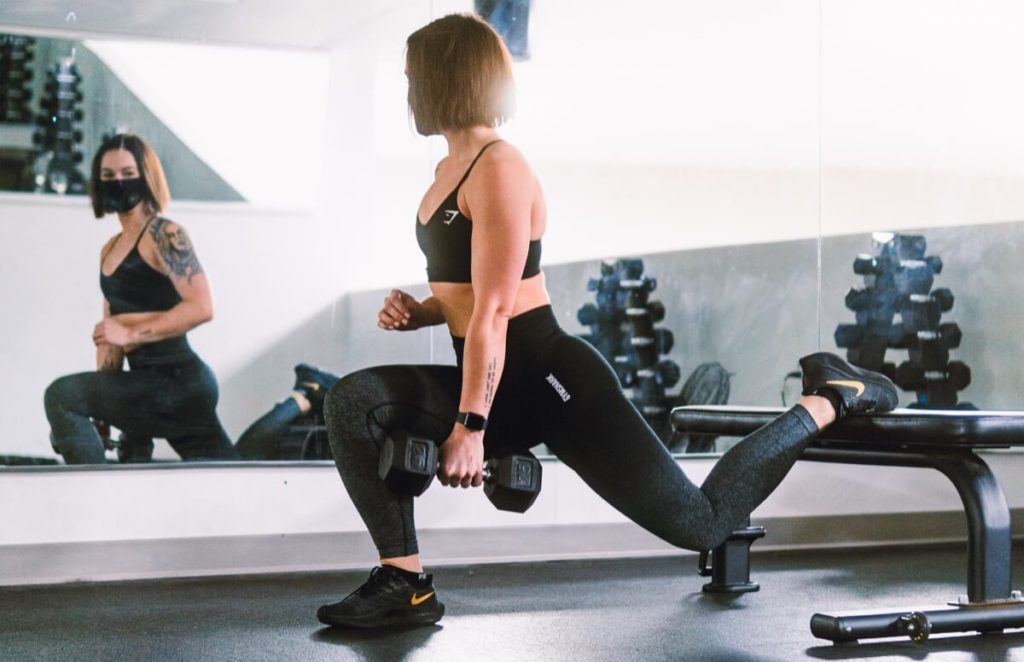

- Stand tall, extend one leg back, and place the foot on an elevated object: gym bench, plyo box, chair, etc.
- Plant your front foot flat on the ground. Have your arms to your sides for balance.
- Retract your shoulder blades, take a deep breath, and engage your abs.
- Descend into a squat by bending your front knee.
- Move down until your front thigh is almost parallel to the floor. Your knee should be directly over your ankle at the bottom position.
- Press through your heel to straighten your front leg and move to the starting position. Exhale.
- Inhale again and repeat.
- Once finished training one side, switch leg positions and do the same number of reps.
Pro tip:
Do the bodyweight version to master proper form and improve your stability. Start holding a pair of dumbbells or weight plates once you’re proficient and can easily do at least 15 controlled reps per leg.
Related article: Best Home Workout for Men: 8 Recommendations for All Levels
Effective Bodyweight Leg Press Alternative Movements
8. Box Jump
Box jumps are a plyometric exercise that serves as an effective leg press alternative.
The movement relies on explosive movement, which recruits a large percentage of fast-twitch muscle fibers in the lower body. As a result, box jumps develop power (rate of force production) and make you more athletic.
An added benefit is that you don’t need any equipment apart from a sturdy object. For example, a plyo box works well because these come in various sizes, but you can also use a gym bench.
How to:
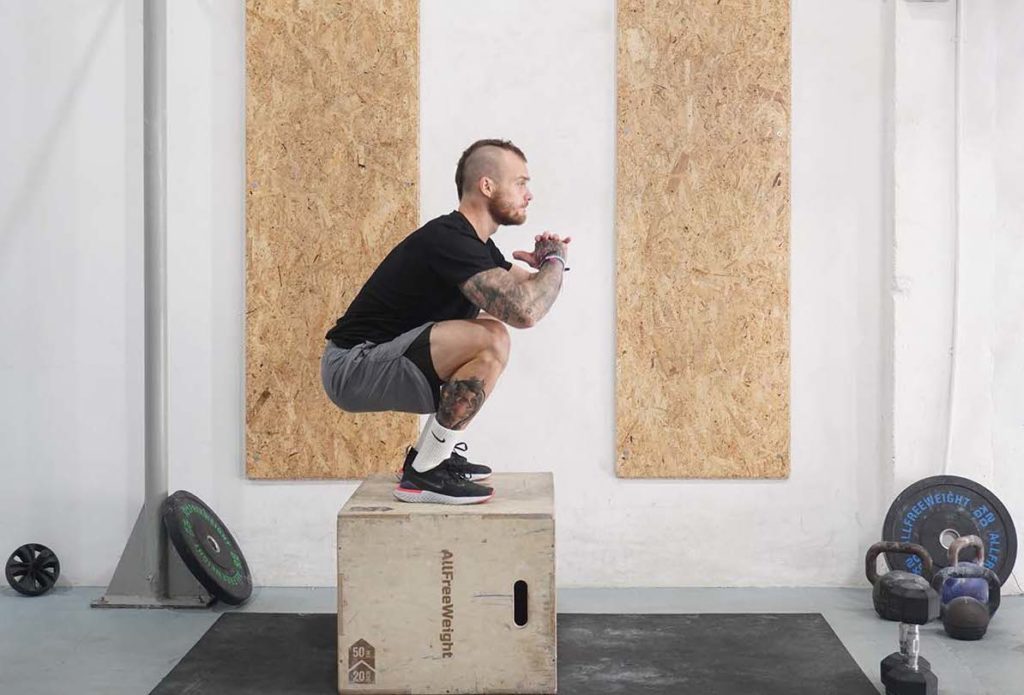

- Stand in front of an elevated object (plyo box, gym bench, etc.) with your feet shoulder-width apart, toes pointing slightly out, and arms to your sides.
- Retract your shoulder blades, engage your abs, and inhale.
- Bend your knees to descend into a quarter squat as you lean your torso forward to generate momentum. At the same time, extend your arms behind your torso.
- Press through your heels as forcefully as possible and swing your arms forward, propelling yourself into a vertical jump.
- Land on the elevated object as you exhale and carefully step back.
Pro tip:
You can start practicing the exercise without an elevated object. Once you have some experience, start using a standard plyo box, which is 20 inches tall. For reference, a typical gym bench is roughly 15 to 17 inches tall.
9. Assisted Pistol Squat
The assisted pistol squat is an advanced at-home leg press alternative that develops the quadriceps, hamstrings, glutes, and midsection.
Like Bulgarian split squats, the movement trains one leg at a time, which is beneficial for preventing side-to-side muscle imbalances.
Another benefit of assisted pistol squats is they provide an excellent training stimulus because you must support your entire body weight on one leg. Even stronger individuals can overload their quadriceps with a few sets of pistol squats.
How to:
- Stand next to a sturdy object you can hold onto for balance.
- Retract your shoulder blades, engage your abs, and take a breath.
- Lift your left foot off the floor and keep your right foot flat on the ground.
- Descend into a squat by bending your right knee and extending your left leg forward.
Go down until your right thigh is roughly parallel to the floor, and press through the heel to straighten your leg. Exhale near the top. - Once finished training the right leg, plant your left foot on the floor, lift the opposite one in the air, and do the same number of reps.
Pro tip:
Pistol squats rely on good ankle mobility because your knee will be in front of your foot at the bottom.
Take extra time to warm up your ankles through mobility exercises, such as static stretches, to boost your performance. Here’s one example:
- Stand against a wall and have the toes of one foot several inches away.
- Lean on the leg and drive the knee forward as much as possible while keeping the heel flat.
- Hold for up to 60 seconds and repeat for your opposite ankle.
Resistance Band Exercise Alternatives to The Leg Press
10. Spanish Squat
Spanish squats are an excellent but underrated leg press alternative with bands. The goal is to place a heavy band behind your knees, anchor it on a sturdy object (e.g., squat rack), and have it pull you forward.
The position allows athletes to maintain vertical shins during the exercise and sit back without losing their balance. As a result, Spanish squats train the quadriceps through a full range of motion without putting any stress on the knees.
Physiotherapists often recommend the Spanish squat to trainees recovering from a knee injury. The movement is also helpful for those experiencing patellofemoral pain (in the front, around the kneecap) during other quad exercises.
How to:
- Take a strong looped resistance band and tie it to a sturdy object, such as a squat rack beam. The band should be at roughly knee height.
- Step inside the resistance band and position it against the back of your knees.
- Take a few steps back to stretch the resistance band, allowing it to support your body weight.
- Have your feet in a comfortable stance with your toes pointing slightly out, retract your shoulder blades, and engage your abs.
- Inhale and descend into a squat.
- Keep your weight on your heels and descend until your thighs are parallel to the floor. You can extend your arms forward for balance.
- Pause at the bottom for a moment and press through your heels to move back to the top position. Exhale.
Pro tip:
Unlike other squat variations, there shouldn’t be any movement at the hips that causes forward torso lean. Imagine that your back is against an invisible wall. The objective is for your torso to move up and down in a straight line.
11. Squat (Band)
Banded squats are another effective resistance band alternative to leg presses. The objective is to step over a looped resistance band and wrap it over your body to get the necessary resistance for an effective workout.
One notable advantage of band squats is that the resistance gradually increases as you straighten your knees, leading to a forceful quad contraction at the top.
How to:


- Take a looped resistance band and step over it. Use the same stance you would for other squat variations––feet roughly shoulder-width apart with your toes pointing slightly out.
- Grab the opposite end of the resistance band, stretch it, and place it behind your head and against your upper back. The band should be fairly stretched at that point.
- Hold the resistance band with both hands, retract your shoulder blades, and engage your abs.
- Inhale and descend into a squat while keeping your heels on the ground.
- Move down until your thighs are parallel to the floor, and press through your heels to bring yourself to the top. Exhale.
Pro tip:
Another way to perform the exercise is to step over a band and loop it over your shoulders. The position is similar to front squats and forces you to maintain a more upright posture.
FAQs
1. Can I train my legs without the leg press?
Absolutely. As you can see, there are plenty of alternatives to the leg press machine. You can always find creative ways to train your quadriceps, hamstrings, and glutes, regardless of your available equipment.
2. How do I do a leg press without a machine?
You need a machine to perform the leg press, but some neat alternatives offer similar benefits.
For example, you can leg press on a Smith machine by lying on the floor and pressing the bar toward the ceiling. Similar movement patterns to the leg press include machine hack squats, Smith machine squats, Spanish squats, and goblet squats.
3. Can I replace the leg press with deadlifts?
Deadlifts are not the best leg press replacement because they are a compound exercise that primarily trains the posterior chain: glutes, hamstrings, and back (7). In contrast, the leg press is an isolation exercise focusing on the quadriceps.
4. Can I do a leg press at home?
No, unless you have a leg press machine at home. Still, you can do fun and effective alternative exercises, including band squats, Spanish squats, assisted pistol squats, and Bulgarian split squats.
Final Thoughts
The leg press is a popular exercise for good reasons. It strengthens the lower body, provides excellent back support, and is relatively easy to learn.
Still, there are plenty of leg press alternatives to strengthen and develop your quadriceps if you’re sick of the movement or don’t have access to that machine.
Some of the above movements are more similar to leg presses than others, but each offers unique benefits and deserves consideration.







Hevy – Workout Tracker
Create and log your leg press alternative exercises with Hevy and track your progress
Are you looking for a simple app to track your workouts and find excellent exercises for each muscle group? Check out the Hevy app.

